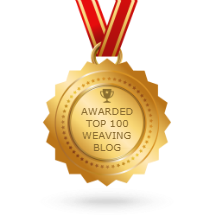|
|
Just a quick post (really busy still making Christmas presents instead of blogging)…
Michael sent me this great photo of his bloodhound, Dixie, all spruced up for Christmas. 
Best I can figure from long-distance reports, Dixie has two modes – this one, and a bit of bullheaded action. God forbid she should listen to her master calling her instead of following her nose. But she is adorable.
Your turn: got any cute photos of animals or people in Santa hats to share?
When I’m not weaving, I work for Pfeiffer Nature Center. It’s really a fine place to work, with the most amazing group of volunteers I’ve ever known. The most active of those volunteers are the 13 members of the Board of Directors. As a small token of my appreciation for everything they do all year, I give them each a holiday gift.
Working part-time for a not-for-profit agency, as you might imagine, money is always tight. So even a few bucks each times 13 people adds up pretty quickly. As a result, my gifts to the Board are always handmade. In years past they’ve received raspberry vinegar, canned dilly beans, elderberry liqueur, blackberry jam, and holiday cookies, all coming out of my kitchen.
This year, they got a combination of kitchen work and living room work.
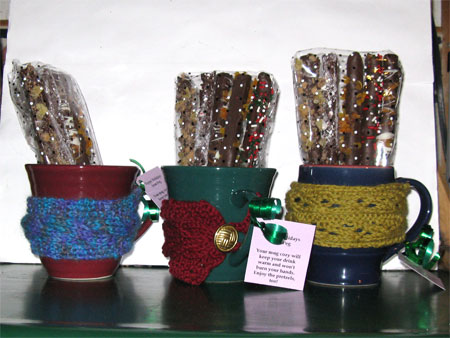
I knit 13 mug cozies from various colors of wool, closing them all with a vintage button from my extensive collection. I wrapped them around cheapie mugs. Much as I would have liked to buy hand thrown mugs from one of the many local potters, I had to buy from the dollar store.
Then I made a variety of dipped pretzels. They included pretty traditional options – chocolate rolled in crushed peppermints and chocolate rolled in red, white & green sprinkles. Then I got more creative. Chocolate drizzled with caramel & white chocolate, chipotle chocolate rolled in chopped dried apricots, and pretzels first dipped in caramel, then chipotle chocolate, and finally drizzled with white chocolate. And my personal favorite — chocolate rolled in a combination of finely minced crystallized ginger and toffee crunch bits.
I was happy with the results, although I do wish I’d realized that the cozies work better on mugs with straight sides instead of the shapes I got. With bottoms smaller than tops, the cozies drifted down toward the table pretty quickly. C’est la vie. I’m making more for my show this weekend, and for other small gifts.
Your turn: are you making any gifts you’re giving this year?
By the time I had the scarf and hat done for my customer with the chemical sensitivities, I was really into working with that thick, soft, warm yarn. So I had to weave something else!
I warped the loom for only 2 scarves. I had a show coming up that I wanted to bring them to, and was pressed for time, so figured I could get 2 scarves on and off. Here they are.
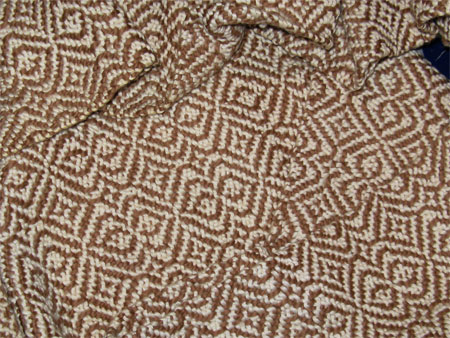
Truth be told, I think I like the original custom scarf, woven in a simply plain weave, houndstooth pattern, better than these. I know I like the fiber better than many of my customers. They are soooooo soft & warm, they make me just want to cuddle up with them. But you don’t know that if you don’t touch them. And you won’t touch them if you’re too attracted by the sheen of rayon chenille, or the lightness of cashmere & silk, or….well, you get the picture. Anyway, the bulky organic cotton scarves didn’t sell at that show, so I did subsequently get them up on my website.
After I wove the two scarves I had quite a bit of warp left, and couldn’t let it go to waste, so I decided to try my hand at some wrist warmers. The concept is this…you have veins very close to the skin on your wrists. That’s why you put perfume there – the natural warmth of your wrists, because of those veins, warms the perfume and scents the air. When you’re really hot in the summer, rub an ice cube over your wrists; it’ll rapidly cool the blood and cool you off. But in the winter, if your wrists are cold, the rest of you will likely be cold, too. So get your wrists warm and that warmth will spread. Makes sense, eh?
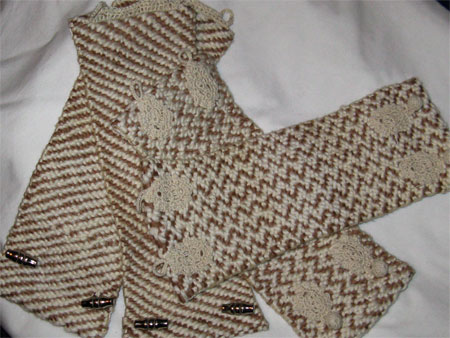
I found some really lovely vintage crocheted frog closures online that I couldn’t resist, but only enough for 2 of the 3 pairs of wrist warmers I made. I used vintage buttons for the third pair, and crocheted the button loops. Here’s a closeup of the closures. (Ignore the fact that I haven’t yet trimmed the thread I sewed them on with.)
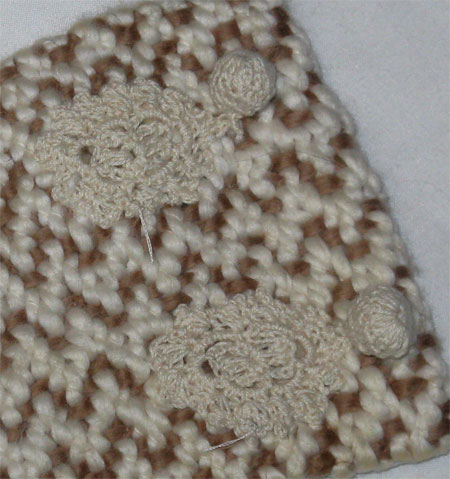
Your turn: what do you cover first when you’re chilly? Me? I reach for a scarf.
I’ve tried making handwoven scarves with organic cotton before, and wasn’t happy with the results. I know now that some of that was due to my (lack of) weaving skills, that I wasn’t using the colorgrown organic cotton to its best advantage. I also know that some of it was simply the materials, and the fact that they weren’t the most suitable fiber for my planned finished product.
So when I got an email from a woman with multiple chemical sensitivities who wanted me to weave her an organic cotton scarf, I was a bit apprehensive. I didn’t think the colorgrown cotton would be soft & warm, no matter what weave structure I used. But then I had a brainstorm!

Hiding in a box (out of sight, out of mind) was a lovely bulky organic cotton I’d purchased at least 18 months ago. That would make a wonderfully warm scarf! You can see the different in yarn size in this picture — the colorgrown cotton looks like sewing thread in comparison to the bulky cotton.
I had two colors of bulky organic cotton – pecan and a creamy white. I had no idea how the cotton had been dyed, I mailed samples to my potential customer to see if it would work next to her skin. We were both very happy that it was fine.
Next up was determining weave structure. Since cold weather was coming, she wanted something as soon as possible. Because I was really busy, I wanted something that fit into my schedule. I met both criteria by deciding to use the organic cotton on my rigid heddle loom to demonstrate weaving at the next show. I didn’t want to do log cabin, stripes, or a plaid, so I suggested a simple houndstooth pattern, which was fine with the woman. I was really happy with the results — the scarf was thick, warm, and soft, providing a great balance between being flexible enough to make it easy to wear and being substantial enough to keep her neck warm. Unfortunately, I forgot to take a photo of the scarf before I mailed it out to her, but here’s the weave pattern.
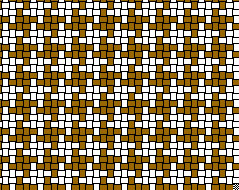
It’s a very simple plain weave, with great effect. In fact, I used the same weave pattern on my rigid heddle within a few weeks with the lovely alpaca. So what is it? Two strand of white, alternated with two strands of pecan, in both warp and weft, woven in a simple plain weave. The end result looks much more complex, at least to my eye. I used a 6.5 DPI (dents per inch) heddle for the bulky organic cotton, and an 11.5 DPI heddle for the much finer alpaca.
The woman liked the scarf well enough that she wanted me to make her a hat. Well, I don’t have the skill to weave something that would easily make a hat, so I suggested knitting her one, instead. She agreed. I wasn’t particularly happy with the results of the hat – not very elegant, but it would keep her head warm.
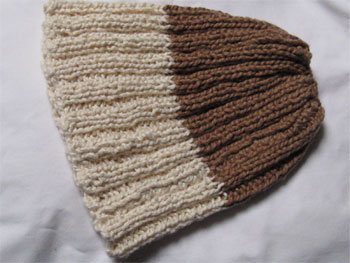
Stay tuned to see what I’ve subsequently woven with that bulky organic cotton.
Your turn: I have a bunch of yarn I’d love to use, so this Your Turn is completely self-serving. Have you ever used colorgrown organic cotton? What were your successful projects with it?
Hope you had a very happy Thanksgiving, spending it just as you wished to.
I’m a crazy woman, I know. I can’t seem to help myself.
At 4:30PM on Monday I drove to the post office to pick up a package I had to sign for – 6 cones of mohair I’d ordered. I figured I’d quickly warp up my rigid heddle loom for 1 scarf to try this new-to-me fiber, wet finish it, brush it, and bring it with me to Shea’s Shopping Soiree on Wednesday. What the heck, I had almost 36 hours before I had to leave the house!

As anticipated, all that hair made it a bit of a challenge to work with, but on the rigid heddle loom it’s pretty easy to hand-separate the fibers with every pass of the shuttle. Which is what’s required. At least on this loom — there are techniques to make it a bit easier on my floor loom.
But for me, the real challenge was the wet finishing. I’ve never fulled wool before (making the fibers thicker and tighter through agitation), at least not on purpose. I do remember accidently washing a wool vest that ending up fitting my cat, but that’s another story.
Mohair is woven quite loosely (it would be impossible to work with it if woven tightly), so it’s essential to full the wool to make the scarf stable. There are a few methods of doing this. On a sample, I tried doing the “shock” method – repeatedly slamming the piece onto a hard surface, gathering it up, and doing it again. Well, I was tired just with doing the sample piece, and it was clear it wasn’t done enough. So I gathered my courage and went downstairs to my washing machine. In went the scarf and the water, turn it to agitation. Open the washer every minute or so to check how the scarf is doing. Sounds relatively easy, until you realize that as a fulling virgin, I had absolutely no idea what it should look like when it was done! I made a semi-informed guess, and took it out when I got too scared to leave it in longer.
Then I brought the scarf upstairs, rolled it in a towel to get rid of most of the moisture, and started brushing it to bring out those wonderful hairs. This step was also scary. Despite having watched a very helpful video by Laura Fry and getting written instructions from Evelyn Oldroyd when she sold me the mohair, it was quite frightening to take a stiff dog brush to a scarf I’d just woven!
I decided that it was a great first attempt. Next time I’ll full a bit more. And there will be a next time, with 6 cones of gorgeous mohair!
Your turn: what have you done that, while scary during the process, stretched your skills at something?
|
|










